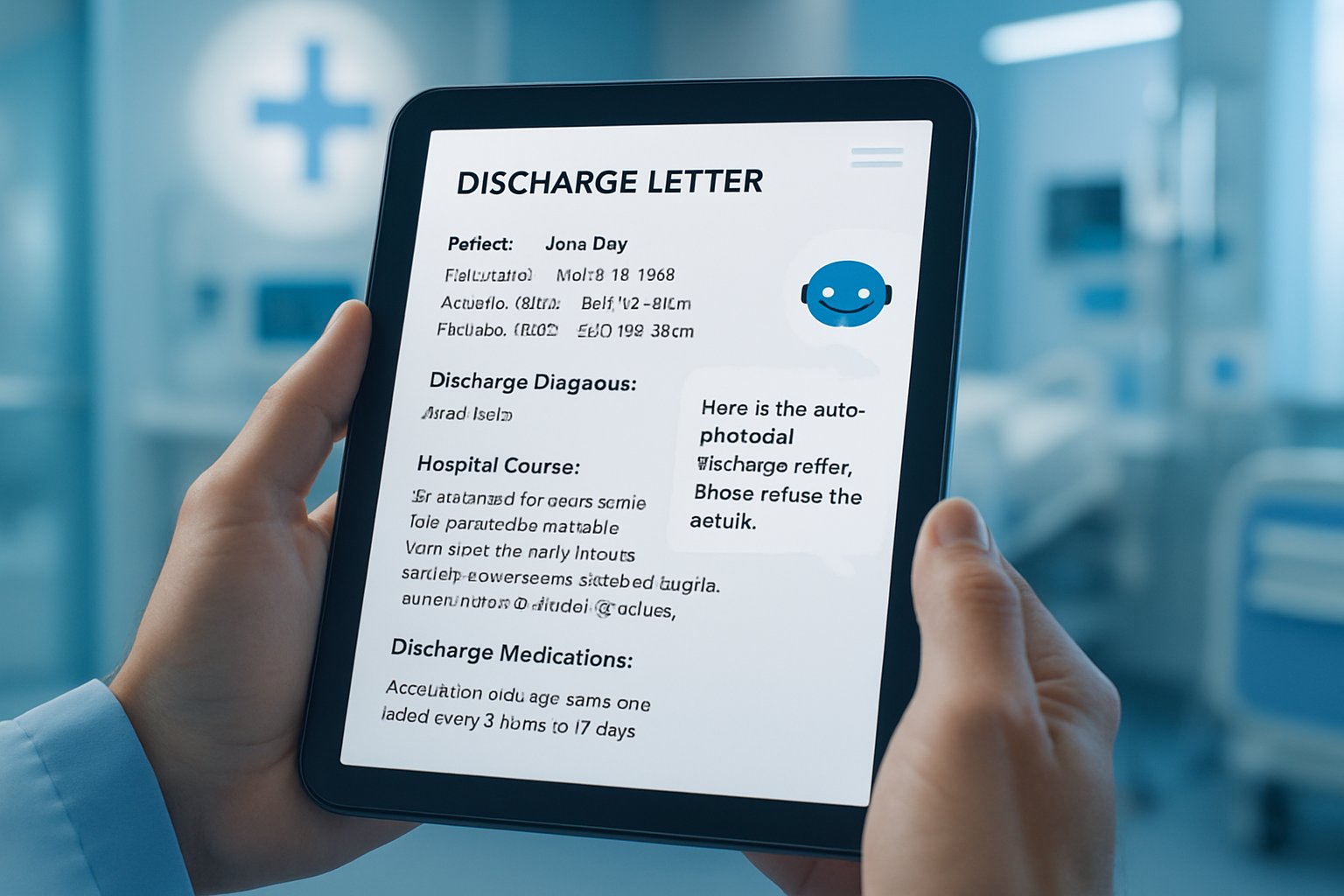
AI CERTS
20 hours ago
NHS Discharge Pilot Shows Power of Healthcare AI Automation
Clinicians currently spend 30–60 minutes assembling each letter. Moreover, consistent documentation demands careful cross-checks of diagnoses, tests and medications. Healthcare AI automation therefore appeals to overstretched teams. Therefore, analysts argue an accurate draft delivered in seconds would improve hospital efficiency and release time for care. Nevertheless, experts insist that human sign-off, regulatory oversight and transparent data governance remain essential before nationwide deployment.

NHS Digital Transformation Drive
The discharge generator sits within a wider NHS digitization agenda shaping policy this decade. Consequently, DSIT launched the “AI Exemplars” portfolio in August 2025 to showcase pragmatic use cases. Ministers Wes Streeting and Peter Kyle framed the pilot as proof of practical change. They argued healthcare AI automation removes repetitive tasks and lets clinicians refocus on patients.
Government briefings cite potential £45 billion productivity gains across public services. However, independent analysts stress the figure aggregates multiple sectors, not just health. Nevertheless, the headline promise amplifies political momentum behind the pilot.
These policy drivers explain why NHS digitization leadership matters. Consequently, understanding the technology itself becomes the next priority.
How The Tool Works
The prototype ingests structured and unstructured data from the electronic health record via the Federated Data Platform. Moreover, a large language model extracts diagnoses, procedures, abnormal results, medications and key dates. It then composes a draft letter following the trust template. This example of healthcare AI automation illustrates targeted use of language models.
Clinicians remain responsible for review, edits and final sign-off. Consequently, the design follows a human-in-the-loop pattern endorsed by NHS governance minutes. Explainability logs show which record entries the model used, helping reviewers validate content quickly.
Its natural-language core accelerates medical records processing before clinicians intervene.
The draft typically includes:
- Admission and discharge dates
- Primary and secondary diagnoses
- Key investigations and results
- Procedures performed
- Medication changes and follow-up actions
These workflow steps illustrate why clinicians can start with a near-complete document. Nevertheless, real value depends on measurable productivity improvements, explored next.
Productivity And Flow Gains
Drafting a discharge summary currently takes 30–60 minutes per patient, according to vendor literature. Therefore, even a 50 percent reduction could release significant clinician time across high-turnover wards. Healthcare AI automation could therefore translate minutes saved into earlier bed turnover. Across multiple trusts, healthcare AI automation pilots will clarify scalable efficiency gains. Early non-AI coordination pilots in north-west London already shaved an average day from stays for some groups.
Government statements link these micro-savings to macro-level capacity gains. Moreover, DSIT argues that freeing beds sooner reduces elective backlogs.
Nevertheless, no independent evaluation for the Chelsea and Westminster pilot has been published. Consequently, stakeholders await data on average drafting time, error rates and GP query volumes.
Potential gains appear compelling, yet evidence remains emergent. Therefore, governance safeguards merit equal scrutiny in the following section.
Governance And Safety Measures
NHS governance documents emphasise that the tool processes data solely for direct care. Additionally, the privacy notice states patient data are not used for AI learning at present. Palantir acts as processor for the Federated Data Platform, while trusts remain data controllers.
Meanwhile, regulators consider the software a potential medical device. The MHRA “AI Airlock” programme lists safe summarisation as an active use case. Therefore, developers must show post-market surveillance and clinical safety evidence.
Regulatory Pathway Status Update
FDP Check & Challenge minutes describe classification work and template testing with GPs. Moreover, they require explainability logs and junior doctor training assessments. Nevertheless, classification documents and safety metrics remain unpublished.
Robust governance must accompany any healthcare AI automation touching direct patient care. Professionals can enhance their expertise with the AI Healthcare Specialist™ certification, which covers clinical governance for automation projects.
Robust oversight frameworks exist, yet transparency gaps persist. Consequently, unresolved challenges deserve closer attention next.
Challenges And Open Questions
Data-sharing controversies still shadow the Federated Data Platform. In contrast, campaign groups fear broader data access for external vendors. Clinicians also worry that patient discharge AI might erode training if juniors stop writing summaries themselves.
Furthermore, large language models can hallucinate plausible but wrong statements. Consequently, reviewers must detect subtle errors before letters reach GPs. Hospital efficiency can suffer if extra checks offset drafting savings.
Independent evaluation data remains absent. Moreover, the vendor and model architecture are undisclosed publicly. Therefore, trust hinges on timely evidence and transparency.
These challenges highlight critical gaps. However, strategic planning could still enable safe scaling, discussed in the final section.
Implications For Wider Rollout
NHS England intends to evaluate pilot results before national deployment. Additionally, scaling will require standardised templates across trusts and alignment with GP systems. Vendor transparency and patient engagement initiatives will further influence adoption.
Consequently, hospitals exploring healthcare AI automation should map clinical governance, data protection and change-management plans early. They must also integrate patient discharge AI with existing medical records processing workflows to avoid fragmented documentation.
Moreover, procurement teams should demand clear evidence of hospital efficiency gains. They should request edit-rate dashboards, safety incident logs and model update schedules.
Strategic alignment, evidence and transparency will determine success. Consequently, a balanced approach can unlock sustained gains across NHS digitization efforts. Successful healthcare AI automation could become a flagship for NHS digitization.
Conclusion And Forward Outlook
The NHS discharge-summary pilot demonstrates practical promise for healthcare AI automation when governed carefully. Nevertheless, success hinges on transparent metrics, rigorous safety oversight and stakeholder trust. Moreover, hospitals must keep clinicians firmly in control while integrating patient discharge AI into medical records processing routines. Consequently, leaders should monitor evaluation data and engage openly with patients and staff. Meanwhile, regulators will publish Airlock findings over the coming year. Stakeholders should prepare briefing packs that translate technical work into clinical value. Consequently, early adopters will shape procurement standards for the next wave of solutions. Professionals seeking to drive responsible innovation can deepen their skills through the AI Healthcare Specialist™ pathway. Act now to position your organisation for efficient, patient-centred, AI-enabled care.



